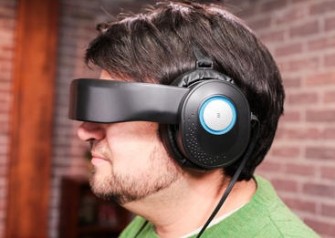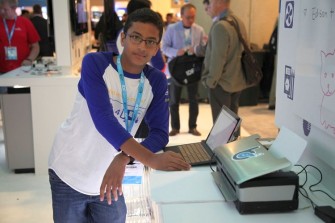Overall, the Group’s venture capital arm is investing $ 62 million into it. Among the most spectacular projects include the California company Avegant and their virtual reality goggles Glyph, and the company Braigo Labs of the only 13-year-old Shubham Banerjee who designed an affordable printer for the blind.

Intel has, among others, the US company Avegant involved, that the virtual reality glasses developed Glyph (image: Avegant).
At its annual conference Intel Capital 16 technology companies presenting at which it has been involved in the past few months. A total of $ 62 million were invested by the venture capital arm of chip-Group. Among its beneficiaries are the manufacturer of eyeglasses for Virtual Reality and the start-up of a 13-year-olds. The German company Nixie also won first place in the Intel competition “Make IT Wearable”.
Avegant headquartered in Redwood City in California working on the virtual reality goggles Glyph. For the project had already been collected on Kickstarter over a million dollars, the current, more traditional financing round at the Intel also participated, brought a further $ 9.37 million. The launch is planned for Glyph 2015. Almost as a complement to technology Glyph Eyefluent can be seen, has also invested in the Intel. The company focuses on eye tracking for use in Virtual Reality.

Shubham Banerjee on with his self-developed braille printer Intel Developer Forum in September (Photo: Braigo Labs).
Braigo Labs was founded by the only 13-year-old Shubham Banerjee. The company has developed from Lego Mindstorms EV3 and the Intel Edison affordable Braille printer. More Companies in which Intel has involved, are PrecisionHawk that collects with drones Air Quality data and analyzes; Audyssey that aims to improve the dieTonqualität for home theater, TV and mobile devices; and Screenovate, which deals with the wireless transfer of movies and games from Smartphones and Tablets on TV.
In parallel, Intel has announced the winners of its competition “Make It Wearable” known. He should encourage companies to develop on the basis of the Edison-processor new. The second prize, $ 500,000 top prize went to the German team Nixie. It has developed a flying camera that can be worn on the wrist when not in use.
[with material from Florian Kalenda, ZDNet.de]
Tip: How well do you know from the European technology history? Check your knowledge – with 15 questions on silicon.de
No comments:
Post a Comment